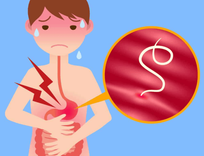Vitamin D plays a crucial role in the formation and development of strong bones. It is also beneficial for boosting the immune system of children. However, vitamin D is a fat-soluble vitamin, and when taken in excessive amounts, it does not naturally excrete from the body but accumulates in fat tissues. At high levels, vitamin D can lead to serious toxicity. Therefore, excessive vitamin D supplementation in infants needs to be monitored to avoid severe consequences.
1. Signs of Excess Vitamin D in Infants
The signs of excess vitamin D in infants are often unclear, which can make it easy for parents to confuse them with other health conditions.
Excessive vitamin D in infants causes an elevated calcium level in the blood. Calcium can then accumulate in the kidneys, potentially causing kidney damage. In adults, excess vitamin D is usually excreted gradually from the body, but for infants and young children, their bodies are more sensitive, leading to more severe signs.
When infants absorb too much vitamin D, they may experience frequent vomiting, excessive thirst, and more frequent urination. They may also show signs of loss of appetite, refusal to breastfeed, fatigue, stomach pain, constipation, joint or bone pain, and general weakness. These symptoms are similar to common conditions in children, such as digestive disorders, constipation, gastroesophageal reflux, bone pain, fever, flu, and excessive crying. Therefore, parents should take their child to the doctor for proper tests to identify the cause of their child’s discomfort. The toxic effects of excessive vitamin D in infants can last up to two months after the source of vitamin D is removed.
2. Harmful Effects of Excessive Vitamin D in Infants
Vitamin D is beneficial for children's health, but if excess vitamin D is given beyond the recommended dose, it can lead to unwanted harm. Some of the harmful effects of excessive vitamin D in infants include:
2.1 High Calcium Levels in the Blood
Adequate vitamin D helps strengthen the immune system and protects children from conditions like osteoporosis and cancer. Vitamin D excess is defined when blood calcium levels exceed 125 nmol/L (50 mg/dL) in infants.
The normal blood calcium range is 8.5–10.2 mg/dL. Excessive vitamin D in infants can lead to unpleasant and potentially dangerous symptoms, including:
- Digestive issues: vomiting, nausea, diarrhea, and stomach pain
- Fatigue, poor concentration, dizziness, and confusion
- Frequent urination
2.2 Stomach Pain, Diarrhea, and Constipation
Stomach pain, constipation, or diarrhea are common digestive issues in infants, often caused by an inability to tolerate food or irritable bowel syndrome. These symptoms are often the result of high calcium levels due to vitamin D toxicity.
These symptoms are most commonly seen in infants receiving high doses of vitamin D or those with excess vitamin D. The signs may vary depending on the child's condition, so parents should carefully monitor any changes in their child's health.
2.3 Increased Risk of Osteoporosis
Vitamin D plays an important role in calcium absorption for bone metabolism. However, excessive vitamin D supplementation can have a negative impact on the health of the bones in young children. High doses of vitamin D can lower the levels of vitamin K2 in the blood. Vitamin K2 is essential for storing calcium in bones and removing it from the blood. Therefore, excessive vitamin D can reduce the function of vitamin K2, which is one of the key factors contributing to bone and joint problems, as well as poor bone development in children.
2.4 Increased Risk of Kidney Damage
Studies have shown that prolonged high doses of vitamin D can lead to rapid kidney damage in infants. In many cases of kidney failure, elevated calcium levels in the blood from a young age are the underlying cause.
3. What to Do if an Infant Has Excess Vitamin D
The first thing to do when vitamin D toxicity or excess is detected in an infant is to immediately stop supplementing vitamin D and reduce calcium intake in the diet. Parents should take the infant to a hospital or medical center and follow the pediatrician's treatment instructions. Proper clinical tests should be conducted, and the infant should be monitored and treated to correct the vitamin D excess.
4. How to Supplement Vitamin D in Infants
4.1. A Diverse and Balanced Diet
First, mothers should ensure a varied and nutritious diet starting from pregnancy, through breastfeeding, and continuing with the child’s daily nutrition. Mothers should focus on foods rich in vitamin D, such as fish, fish oil, cereals, shellfish, mushrooms, and beans. However, it's important to provide a balanced intake of all nutrients, not just focusing on vitamin D to avoid deficiencies in other vitamins and minerals.
Additionally, mothers can consider formula feeding to provide necessary vitamins. Typically, infant formula containing adequate nutrients does not require additional vitamin D supplementation. A daily intake of 500ml of formula will generally meet the vitamin D needs of the child.
4.2. Sun Exposure for the Infant
If the nutrients in the formula are insufficient, parents may need to supplement their child’s vitamin D intake. The simplest and most effective way is to provide daily sun exposure. Sunlight helps the body convert vitamin D effectively and strengthens the child’s bones.
However, to achieve optimal health benefits and ensure the baby’s safety, parents should follow these guidelines when exposing the child to sunlight:
- The baby should be at least 10 days old before sun exposure.
- The best time for sunlight exposure is early in the morning between 7 and 8 AM or after 5 PM, when the sunlight is not too harsh and the UV index is not high. The baby should be exposed to the sun for 10 to 15 minutes.
4.3. Using Vitamin D Supplements
Mothers can also consider vitamin D supplements specifically designed for infants. Since infants cannot take vitamin D in pill form, it’s important to choose liquid supplements and administer them drop by drop. Pediatricians will provide the appropriate vitamin D dosage for those at risk of deficiency, and parents should follow these instructions. While using vitamin D supplements, parents must be mindful of the dosage and administration methods. The safest approach is using the daily recommended dose. High-dose vitamin D supplements should be avoided, as they may lead to vitamin D excess or toxicity in infants.
5. Tips for Choosing Vitamin D Supplements
To ensure that breastfed infants or partially breastfed infants do not receive more than 400 IU of vitamin D per day, health organizations recommend the following:
- Always keep the packaging and instructions of vitamin D supplements for reference when using these products. Ensure proper use and dosage according to the instructions.
- Only use vitamin D supplements that come with a dropper or a measuring device. Do not use the measuring devices from one product for another.
- Choose supplements with a dropper or measuring device that clearly display the dosage units. Ensure that the dosage unit matches the unit in the instructions.
- If you are unsure of the vitamin D content in each dose of the product, consult a healthcare professional before use.
- If your child is fully or partially formula-fed, consult a pediatrician or nutrition expert before giving additional vitamin D supplements to prevent vitamin D excess in infants.
It’s important to remember that all medications or supplements, in addition to their health benefits, may have unintended or adverse effects when taken in excess. Vitamin D is essential for healthy bone development and helps prevent health problems related to cardiovascular diseases, diabetes, and joint issues. However, excessive vitamin D in infants can cause dangerous consequences. Therefore, mothers should only supplement vitamin D according to the prescribed dosage to avoid harm to the child's health.
Please dial HOTLINE for more information or register for an appointment HERE. Download MyVinmec app to make appointments faster and to manage your bookings easily.













